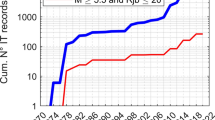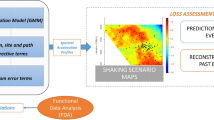Abstract
The current state of the practice in performance-based earthquake engineering relies on using ergodic ground motion models (GMMs), which assume that the ground motion variability observed in a global database is the same as the variability in ground motion at a single site-source combination. However, as empirical ground motion databases have grown, it has become clear that there are significant systematic differences, which depend on repeatable effects for a combination of sites and seismic sources in a particular region. These systematic differences do not support the ergodic assumption, which is prompting the transition from ergodic to nonergodic GMMs. In this study, we use the Ridgecrest ground motion database, which has 20,000 + ground motion recordings, to evaluate the performance of ergodic and nonergodic GMMs. The large number of ground motions in the Ridgecrest database allows us to quantify repeatable effects for a relatively small region, considering earthquakes with a range of magnitudes, which has been seldom attempted in previous efforts. In develo** the nonergodic GMMs, we propose a novel approach based on computer graphics to quantify the cell-specific attenuation terms to constrain the path effects. We use the developed ergodic and nonergodic GMMs to evaluate their performance in earthquake scenarios that occurred in the Ridgecrest area by creating GMM-based maps of ground shaking (MGSs) and comparing them with actual MGSs from recorded ground motions. We use the results from MGSs to assess the assumption in nonergodic GMMs, namely that repeatable effects observed in small magnitude earthquakes are correlated with repeatable effects observed in large magnitude earthquakes. Our results show that the nonergodic GMMs provide information on the spatial variation of repeatable effects induced by complex physical processes; they have a lower aleatory variability, consistent with previous studies; they have a better performance for the considered earthquake scenarios in the Ridgecrest area; and the repeatable effects quantified in small magnitude earthquakes improve the estimation of intensity measures (IMs) at larger magnitudes.















Similar content being viewed by others
Availability of data and materials
The NGA-West2 ground motion database are available in the Pacific Earthquake Engineering Center website (https://ngawest2.berkeley.edu/). The Ridgecrest ground motion database are available in the USGS website (https://www.strongmotioncenter.org/specialstudies/rekoske_2019ridgecrest/).
Code availability
The code implementing Cohen-Sutherland algorithm for cell-specific attenuation can be acquired by email request to the first author.
References
Abrahamson N, Gülerce Z (2020) Regionalized ground-motion models for subduction earthquakes based on the nga-sub database. Technical report
Abrahamson N, Hollenback J (2012) Application of single-station sigma ground motion prediction equations in practice. In: Proceedings of the 15th world conference on earthquake engineering. Lisbon, Portugal (paper 2536)
Abrahamson NA, Kuehn NM, Walling M, Landwehr N (2019) Probabilistic seismic hazard analysis in California using nonergodic ground-motion models. Bull Seismol Soc Am 109(4):1235–1249
Abrahamson NA, Silva WJ, Kamai R (2014) Summary of the ASK14 ground motion relation for active crustal regions. Earthq Spectra 30(3):1025–1055
Ancheta TD, Darragh RB, Stewart JP, Seyhan E, Silva WJ, Chiou BSJ, Wooddell KE, Graves RW, Kottke AR, Boore DM et al (2014) NGA-West2 database. Earthq Spectra 30(3):989–1005
Anderson JG, Brune JN (1999) Probabilistic seismic hazard analysis without the ergodic assumption. Seismol Res Lett 70(1):19–28
Atik LA, Abrahamson N, Bommer JJ, Scherbaum F, Cotton F, Kuehn N (2010) The variability of ground-motion prediction models and its components. Seismol Res Lett 81(5):794–801
Atkinson GM (2006) Single-station sigma. Bull Seismol Soc Am 96(2):446–455
Atkinson GM, Bommer JJ, Abrahamson NA (2014) Alternative approaches to modeling epistemic uncertainty in ground motions in probabilistic seismic-hazard analysis. Seismol Res Lett 85(6):1141–1144
Bates D, Sarkar D, Bates MD, Matrix L (2007) The lme4 package. R Package Ver 2(1):74
Bozorgnia Y, Abrahamson NA, Atik LA, Ancheta TD, Atkinson GM, Baker JW, Baltay A, Boore DM, Campbell KW, Chiou BSJ et al (2014) NGA-West2 research project. Earthq Spectra 30(3):973–987
Carpenter B, Gelman A, Hoffman MD, Lee D, Goodrich B, Betancourt M, Brubaker M, Guo J, Li P, Riddell A (2017) Stan: A probabilistic programming language. J Stat Softw 76(1)
Chen YH, Tsai CCP (2002) A new method for estimation of the attenuation relationship with variance components. Bull Seismol Soc Am 92(5):1984–1991
Dawood HM, Rodriguez-Marek A (2013) A method for including path effects in ground-motion prediction equations: An example using the Mw 9.0 Tohoku earthquake aftershocks. Bull Seismol Soc Am 103(2B):1360–1372
Geli L, Bard PY, Jullien B (1988) The effect of topography on earthquake ground motion: a review and new results. Bull Seismol Soc Am 78(1):42–63
GeoPentech (2015) Southwestern United States ground motion characterization SSHAC level 3. Technical Report, rev. 2
Hastie T, Tibshirani R, Friedman J (2009) The elements of statistical learning: data mining, inference, and prediction. Springer Science & Business Media
Hoffman MD, Gelman A (2014) The No-U-Turn sampler: adaptively setting path lengths in Hamiltonian Monte Carlo. J Mach Learn Res 15(1):1593–1623
Kuehn N, Bozorgnia Y, Campbell K, Gregor N (2020) Partially non-ergodic ground-motion model for subduction regions using NGA-subduction database. PEER Rept. No 2020/04
Kuehn NM, Abrahamson NA (2020) Spatial correlations of ground motion for non-ergodic seismic hazard analysis. Earthq Eng Struct Dyn 49(1):4–23
Kuehn NM, Scherbaum F (2016) A partially non-ergodic ground-motion prediction equation for Europe and the Middle East. Bull Earthq Eng 14(10):2629–2642
Landwehr N, Kuehn NM, Scheffer T, Abrahamson N (2016) A nonergodic ground-motion model for California with spatially varying coefficients. Bull Seismol Soc Am 106(6):2574–2583
Lin PS, Chiou B, Abrahamson N, Walling M, Lee CT, Cheng CT (2011) Repeatable source, site, and path effects on the standard deviation for empirical ground-motion prediction models. Bull Seismol Soc Am 101(5):2281–2295
Macedo J, Abrahamson N, Bray JD (2019) Arias intensity conditional scaling ground-motion models for subduction zones. Bull Seismol Soc Am 109(4):1343–1357
Parker GA, Baltay AS, Rekoske J, Thompson EM (2020) Repeatable source, path, and site effects from the 2019 m 7.1 ridgecrest earthquake sequence. Bull Seismol Soc Am 110(4):1530–1548
Rasmussen CE (2003) Gaussian processes in machine learning. In: Summer school on machine learning. Springer, pp. 63–71
Rekoske JM, Thompson EM, Moschetti MP, Hearne MG, Aagaard BT, Parker GA (2020) The 2019 Ridgecrest, California, earthquake sequence ground motions: processed records and derived intensity metrics. Seismol Res Lett 91(4):2010–2023
Rodriguez-Marek A, Cotton F, Abrahamson NA, Akkar S, Al Atik L, Edwards B, Montalva GA, Dawood HM (2013) A model for single-station standard deviation using data from various tectonic regions. Bull Seismol Soc Am 103(6):3149–3163
Rodriguez-Marek A, Montalva GA, Cotton F, Bonilla F (2011) Analysis of single-station standard deviation using the KiK-net data. Bull Seismol Soc Am 101(3):1242–1258
Rodriguez-Marek A, Rathje E, Bommer JJ, Scherbaum F, Stafford P (2014) Application of single-station sigma and site-response characterization in a probabilistic seismic-hazard analysis for a new nuclear site. Bull Seismol Soc Am 104(4):1601–1619
Sedaghati F, Pezeshk S (2017) Partially nonergodic empirical ground-motion models for predicting horizontal and vertical pgv, pga, and 5% damped linear acceleration response spectra using data from the Iranian plateau. Bull Seismol Soc Am 107(2):934–948
Sobkow MS, Pospisil P, Yang YH (1987) A fast two-dimensional line clip** algorithm via line encoding. Comput Graph 11(4):459–467
Thompson E, Wald DJ, Worden C (2014) Avs 30 map for california with geologic and topographic constraints. Bull Seismol Soc Am 104(5):2313–2321
Trugman DT (2020) Stress-drop and source scaling of the 2019 ridgecrest, california, earthquake sequence. Bull Seismol Soc Am 110(4):1859–1871
Walling MA (2009) Non-ergodic probabilistic seismic hazard analysis and spatial simulation of variation in ground motion. PhD Thesis, University of California, Berkeley
Acknowledgements
This work was partially supported by the Georgia Institute of Technology (Award DE00000701) and Pacific Gas and Electric. We also thank Dr. Norman Abrahamson for inspiring us to work on the development of nonergodic ground motion models and for always being open to discussing technical aspects, which were instrumental in our study. We also thank the U.S. Nonergodic hazard working group for providing feedback and recommendations for our study, in particular we thank Dr. Yousef Bozorgnia, Dr. Nicolas Kuehn, Dr. Grigorios Lavrentiadis, Dr. Maxime Lacour, and Dr. Christine Goulet for the valuable discussions. Finally, we thank the three anonymous reviewers and Dr. Christine Goulet, who provided constructive comments that helped to improve the quality of this study.
Funding
This work was partially supported by the Georgia Institute of Technology (Award DE00000701), and Pacific Gas and Electric.
Author information
Authors and Affiliations
Corresponding author
Ethics declarations
Conflict of interest
The authors declare that they have no conflict of interest.
Additional information
Publisher's Note
Springer Nature remains neutral with regard to jurisdictional claims in published maps and institutional affiliations.
Appendix A
Appendix A
Rights and permissions
About this article
Cite this article
Liu, C., Macedo, J. & Kottke, A.R. Evaluating the performance of nonergodic ground motion models in the ridgecrest area. Bull Earthquake Eng 21, 5347–5373 (2023). https://doi.org/10.1007/s10518-022-01342-x
Received:
Accepted:
Published:
Issue Date:
DOI: https://doi.org/10.1007/s10518-022-01342-x







